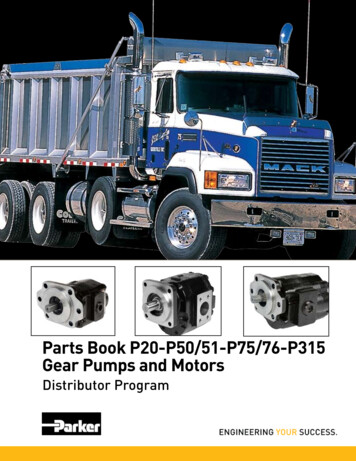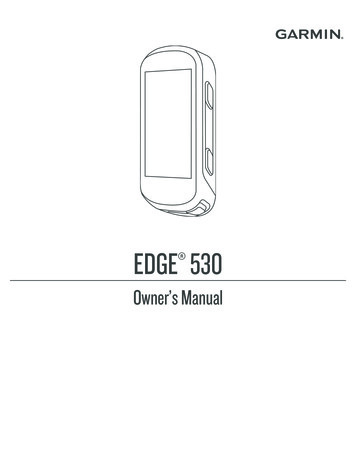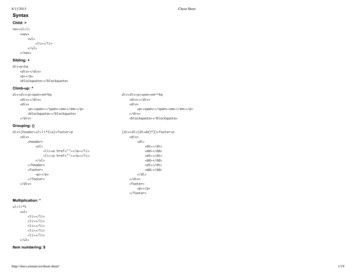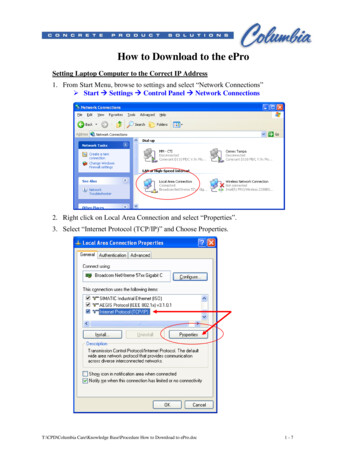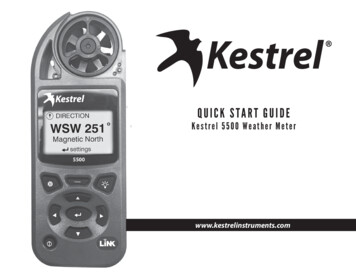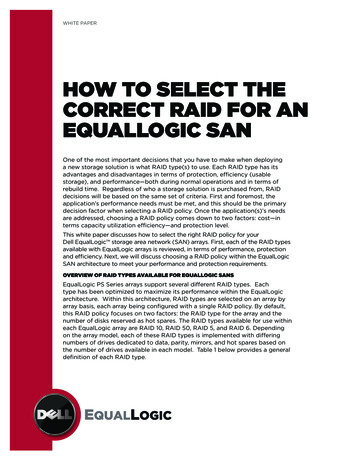
Transcription
WHITE PAPERHOW TO SELECT THECORRECT RAID FOR ANEQUALLOGIC SANOne of the most important decisions that you have to make when deployinga new storage solution is what RAID type(s) to use. Each RAID type has itsadvantages and disadvantages in terms of protection, efficiency (usablestorage), and performance—both during normal operations and in terms ofrebuild time. Regardless of who a storage solution is purchased from, RAIDdecisions will be based on the same set of criteria. First and foremost, theapplication’s performance needs must be met, and this should be the primarydecision factor when selecting a RAID policy. Once the application(s)’s needsare addressed, choosing a RAID policy comes down to two factors: cost—interms capacity utilization efficiency—and protection level.This white paper discusses how to select the right RAID policy for yourDell EqualLogic storage area network (SAN) arrays. First, each of the RAID typesavailable with EqualLogic arrays is reviewed, in terms of performance, protectionand efficiency. Next, we will discuss choosing a RAID policy within the EqualLogicSAN architecture to meet your performance and protection requirements.OVERVIEW OF RAID TYPES AVAILABLE FOR EQUALLOGIC SANSEqualLogic PS Series arrays support several different RAID types. Eachtype has been optimized to maximize its performance within the EqualLogicarchitecture. Within this architecture, RAID types are selected on an array byarray basis, each array being configured with a single RAID policy. By default,this RAID policy focuses on two factors: the RAID type for the array and thenumber of disks reserved as hot spares. The RAID types available for use withineach EqualLogic array are RAID 10, RAID 50, RAID 5, and RAID 6. Dependingon the array model, each of these RAID types is implemented with differingnumbers of drives dedicated to data, parity, mirrors, and hot spares based onthe number of drives available in each model. Table 1 below provides a generaldefinition of each RAID type.1
HOW TO SELECT THE CORRECT RAID FOR AN EQUALLOGIC SANNote: EqualLogic PS Series arrays implement each supported RAID type based on the number of disks in the arraymodel. The diagrams in Table 1 are used only to illustrate the basic definition of each RAID type and do not represent theactual RAID implementation of a PS Series array.Table 1: RAID DefinitionsRAIDDescription10RAID 10 (mirrored sets in a striped set) combines thebest of two high performance RAID types —RAID 0 and RAID 1. A RAID 10 is created by firstbuilding a series of 2 disk RAID 1 mirrored disks, andthen distributing data over those mirrors. Given 16x1 TB disks, a RAID 10 implementation would be ableto host 8 TBs of data.ExampleRAID 10 implementations can sustainmultiple drive losses so long as no RAID 1(mirrored) set loses both of its drives.50RAID 50 (RAID 5 sets in a striped set) iscreated by first creating two or more RAID 5 sets,and then striping data over those RAID 5 sets.Given 16x 1 TB disks, a RAID 50 implementationwould be able to host 14 TBs of data andreserving 2 TB of space for parity.RAID 50 implementations can tolerate a singledrive failure per RAID 5 set.5RAID 5 (striped disks with distributed parity)combines three or more disks in an arrangementwhere each stripe consists of N data blocks and1 parity block (often referred to as N 1). Given16x 1 TB disks, a RAID 5 implementation would beable to host 15 TBs of data and reserving 1 TB ofspace for parity.RAID 5 implementations can tolerate a single drivefailure without data loss.6RAID 6 (Striped set with dual distributed parity)extends the concept of RAID 5 to the use of 2parity blocks per stripe (referred to as N 2). Given16x 1 TB disks, a RAID 6 implementation would beable to host 14 TB of data and reserving 2 TB ofspace for parity.RAID 6 implementations can tolerate up to 2 drivefailures at the same time without data loss.Note: Dx Data blocks, Mx Duplicate Data, Px “Vertical” Parity blocks, Qx “Diagonal” Parity blocks2
HOW TO SELECT THE CORRECT RAID FOR AN EQUALLOGIC SANRAID SELECTION CRITERIA The amount of processing required to providedata protectionWhen comparing RAID types, three specificcharacteristics should be considered: performance,storage efficiency, and data protection. Thesecharacteristics will determine which RAID type willmeet your application, business and administrativeneeds. As a storage administrator, you must workwith the application owner to determine which ofthese characteristics are more important. To helpgain a better understanding, consider each in detail.This factor is focused on RAID types that requireparity calculation such as RAID 5 and RAID 6arrays. Calculating parity is a very computeintensive process and requires the storagearray to focus some of its processing power toperforming these calculations rather than simplysending or receiving data from an application.For every write operation, a RAID 5 array requiresadditional read operations, as well as processingto calculate the parity, before it can committhe data write request to disk. A RAID 6 arraymust do this twice as it requires the calculationof two different parity values. In addition, theRAID 6 array must do these parity calculations insequence since the second parity must includethe first parity calculation in its own process.PerformanceOne of the most important requirements ofany application—and thus the storage solutionsupporting it—is meeting the end-user’s expectationsfor speed and responsiveness. The performancecharacteristic of a storage solution’s RAID type hasa direct impact on this application requirement.The faster the storage solution is in responding torequests, and to providing data, the faster and moreresponsive the application. RAID performance ismade up of a mixture of factors including: Rebuild time after recovering from a failureAfter a disk failure, a hot spare, if available, willautomatically replace the failing disk and thearray will enter a rebuild state where data fromthe failed disk is reconstructed using the datafrom the remaining disks in the RAID array.Depending on the RAID type, the amount oftime and processing power required to completethis rebuild can have a dramatic affect on thearray’s performance until the rebuild is complete.RAID types involving mirror sets, such as a RAID10 array, can simply copy data from the survivingdisk in the mirror pair. During rebuilds of RAID10 arrays, there are no calculations to perform,and the other mirror sets within the RAID 10set are not affected by the rebuild. RAID typesinvolving parity calculations, such as RAID 5,RAID 50, and RAID 6 may see a drop in arrayperformance. This is due to the need to readdata from all the surviving disks in the failedRAID set and recalculating the parity informationto determine the value of the lost data as part ofthe rebuild process The number of disks dedicated to reading andwriting of dataRAID types that dedicate more disks toprocessing data will provide better performance.This is different from storage efficiency, whichis focused on the number of disks that can beused to respond to a storage request. A RAID10 array has a low storage efficiency requiring50% of its disks to be dedicated to protectingdata in the form of a mirror, but it can use bothcopies of the data in that mirror to respond tostorage requests. This allows all of the disks(100%) to participate in processing data requests.In contrast, a RAID 5 array has a high storageefficiency characteristic since it only requires onedisk’s worth of storage to protect the rest of thedisks, but to have this high storage efficiency,it requires additional processing power that istaken away from processing storage requests.3
HOW TO SELECT THE CORRECT RAID FOR AN EQUALLOGIC SANStorage EfficiencyTable 2: RAID ComparisonIn terms of storage efficiency, each RAID typehas differing levels of storage efficiency. Storageefficiency indicates how much “usable storage”space is available after applying the requirementsof the RAID type to the set of disks. With mostRAID types, storage efficiency goes up as thenumber of disks increases. Others have a fixedefficiency in terms of percentage of raw diskspace, regardless of the number of disks in theRAID set. For example, a RAID 10 array alwaysrequires 50% of its disks to be used to mirror datafrom the other 50% of disks, while RAID 50, RAID5 and RAID 6 arrays’ storage efficiency will varybased on the number of disks in the RAID set asthey require fewer disks to protect the rest of thedisks in the RAID set, which are storing rmance10 / / 50 / / 5 / / 6 / / SELECTING THE RIGHT RAID POLICYSelecting a set of RAID policies for your SANwill have a direct impact on the both the actualand perceived performance of each applicationthat is using the SAN for its primary storage. Asdiscussed earlier, each RAID type has differinglevels of performance, cost, and protection. To beable to make informed decisions, understandingthe reasons for deploying a new SAN will set someexpectations. First, most SANs are deployed toconsolidate storage into a single pool of storageto improve management, reduce the amount ofisolated, unused storage capacity, and to betterprotect the data being stored–possibly due toregulatory requirements. Consolidation impliesthat multiple applications will be utilizing storageresources within the SAN. It is therefore importantto understand each application’s data accessprofile. Using this information, the EqualLogicSAN can be designed to meet the requirements ofall of the applications with minimal compromiseby defining where each application’s data will behosted within the SAN. This allows us to defineRAID types that focus on your application’srequirements and grouping those application’sdata into resource pools that require similar RAIDpolicies.Data ProtectionFinally—and probably most obviously—eachRAID type provides differing levels of protection.Some RAID types will protect from single diskfailures, while others can protect the RAID setfrom multiple disk failures. RAID 10 can recoverfrom multiple disk failures—one disk per mirror set.Therefore, an EqualLogic PS array with 16 disks—14 disk in the RAID set and 2 hot spares—consistsof 7 mirror sets per array and could potentiallycontinue to operate with 7 failed disks. On theother end of the spectrum, RAID 5 (and othersingle parity RAID type) arrays can only toleratea single disk failure. RAID 6 and RAID 50 provideprotection between those of RAID 10 and RAID5, by allowing multiple disk failures—2 disks perarray in the case of RAID 6 and 1 disk per RAID 5set within the RAID 50 array—to occur before thearray is disabled. Table 2 below provides relativeranking of each of the RAID types supported byEqualLogic in terms of these three characteristics.4
HOW TO SELECT THE CORRECT RAID FOR AN EQUALLOGIC SANUNDERSTANDING APPLICATION REQUIREMENTSEqualLogic arrays along with scaling the numberof I/O paths or initiators from the host. RAIDtypes that are most suitable for these types ofapplications typically are the most space efficientas well as read access friendly such as RAID 5,RAID 6, or RAID 50.Understanding your application’s datarequirements is the first step in selecting the rightarray model and RAID policy. Is the applicationaccessing data in a random or sequential fashion?How responsive must the application be to theend user’s requests? How often does the datachange (how many reads versus writes)? Theseare just a few of the questions that will affect SANdesign and RAID policy selection along with howmany RAID policies might need to be deployed.As mentioned at the beginning of this section,application requirements should play a primaryrole within the RAID policy selection process.While nothing can substitute for real-worldtesting, some general characteristics for varioustypes of applications can provide some guidance.Table 3 lists some of the primary applicationtypes along with the suggested RAID policies thatshould be considered.The prevalent application environments are randomaccess in nature, which are bound by IOPS andlatency. Examples of these types of application aretransaction oriented database applications, pointof-sale applications, and large email solutions.Since these types of applications require storagesolutions that can generate high I/O with minimallatency, the storage solution should support RAIDtypes that can be created with a large numbers offast disk drives. Any RAID type supported by theEqualLogic PS Series array would be suitable to thistype of access model, but RAID 10 and RAID 50 areprobably the best here because these RAID typeswork better where requirements indicate a higherpercentage of data writes while providing a largenumber of spindles to support higher read I/O andrelatively better write I/O.Table 3: Application Types and RAID ConsiderationsApplication TypeCandidate RAID PoliciesFile/NAS Services5, 6, 50Messaging10, 50DatabaseRandom, Transactional (OLTP)10, 50Sequential ( 75% Read), DSS/6, 5, 50Data WarehouseSequential ( 25% Writes)50, 6, 5IMPACT OF THE VIRTUALIZED PEER STORAGEARCHITECTURE ON RAID SELECTIONEqualLogic SANs consist of one or more PS Seriesarrays working cooperatively to provide optimalperformance and protection to your applicationsvia load balancing. Each array has a dedicatedRAID policy allowing the array to automaticallyoptimize its performance based on thecharacteristics of that RAID type, providingthe best performance possible from any of thesupported RAID policies. Each RAID policyconsists of a RAID type and a defined numberof disks designated as hot spares. By default,EqualLogic reserves 1 drive as a hot spare forRAID 5 and RAID 6 and reserves 2 drives as hotLess common are applications that access datain a sequential fashion such as data warehousing,video processing, and other large decisionsupport applications. These applications requirethe storage solution to have the ability to transferlarge amounts of data (usually reads and notwrites) in a timely fashion and require very largenetwork and storage configurations to meetoverall throughput. A single storage array mayfall short of the high throughput required by anapplication that accesses data sequentially, butthis bottleneck can be removed by appropriatelyscaling the SAN, through the addition of other5
HOW TO SELECT THE CORRECT RAID FOR AN EQUALLOGIC SANspares for RAID 10 and RAID 50. The number ofdisks reserved as hot spares can be reduced, butonly through the use of the command line interface(CLI). Dell does not recommend that the number ofhot spares be reduced from the default number.migration is performed. For small SANs consistingof only a few arrays, this RAID policy conversionability is a great feature to have available. Table 4lists the possible RAID policy migration options.Table 4: RAID Migration OptionsThe power of the EqualLogic SAN design comesfrom combining multiple arrays. Each array inthe SAN group can be configured a with differentRAID policy. Organizing arrays into differentresource pools provides a tiered storage featurethat may help to improve overall performance.Resource pools can host arrays with the sameRAID policy as well as arrays with differing RAIDpolicies. Each resource pool allows volumes to beload balanced across multiple arrays within thepool based on application performance needs.Current RAID PolicyCan Convert To105, 50, 65NONE505, 665, 50CONCLUSIONSRAID selection is a key decision that must bemade for any advanced, consolidated storage areanetwork solution. Before any RAID policy choicescan be made, you must understand what each RAIDtype is, what the pros and cons of each are in termsof performance, cost, and the amount of protectionthey provide and taking your applications storageperformance requirements into account. Only thencan you make informed choices during the planningphase of your storage design.When a resource pool contains arrays that allhave the same RAID policy, additional arraysadded to this pool not only increases the capacityof the pool, but also increases the performancethrough the addition of additional processpower, additional network connections, andadditional spindles to host each volume in thepool. When a resource pool contains multiplearrays with different RAID policies, the SAN cantake advantage of the differing RAID types byautomatically moving volumes (and the data theycontain) onto a different RAID type depending onthe usage patterns experienced as the volume isaccessed over time. This process is automatic bydefault and happens without the awareness of theapplications that are using the volumes.Within the EqualLogic architecture, RAID playsan important role in ensuring the storage solutionthat provides the best performance possible whilealso providing cost conscious data protectionalong with advanced features only available witha virtualized storage solution. This virtual peerstorage model allows you to not only grow yourSAN’s capacity as your needs change, it also allowsyou to implement more advanced functionalityand provides flexibility features such as automatedvolume migration, automatic distribution ofvolumes over multiple arrays with the same RAIDpolicy and the ability to organize the storage intoresource pools. All of these capabilities can beimplemented without negative impacts on theoperation of the host application and withoutbringing the storage down for maintenance.Another feature of the virtualized peer storagearchitecture of the EqualLogic family is the abilityto, with some limitations, change an arrays RAIDpolicy. So, even if you do not initially pick theright RAID policy for your application(s) or yourapplication’s requirements change, you might beable to change that RAID policy to a better RAIDpolicy—all without the awareness of the applicationother than a temporary performance change as the6
SIMPLIFY YOUR STORAGE AT WWW.DELL.COM/PSseriesTHIS WHITE PAPER IS FOR INFORMATIONAL PURPOSES ONLY, AND MAY CONTAIN TYPOGRAPHICAL ERRORS AND TECHNICALINACCURACIES. THE CONTENT IS PROVIDED AS IS, WITHOUT EXPRESS OR IMPLIED WARRANTIES OF ANY KIND.7 2009 Dell Inc.WP916 USA 032409
RAID 10 (mirrored sets in a striped set) combines the best of two high performance RAID types — RAID 0 and RAID 1. A RAID 10 is created by first building a series of 2 disk RAID 1 mirrored disks, and then distributing data over those mirrors. Given 16x 1 TB disks, a RAID 10 implementation would be able to host 8 TBs of data.



